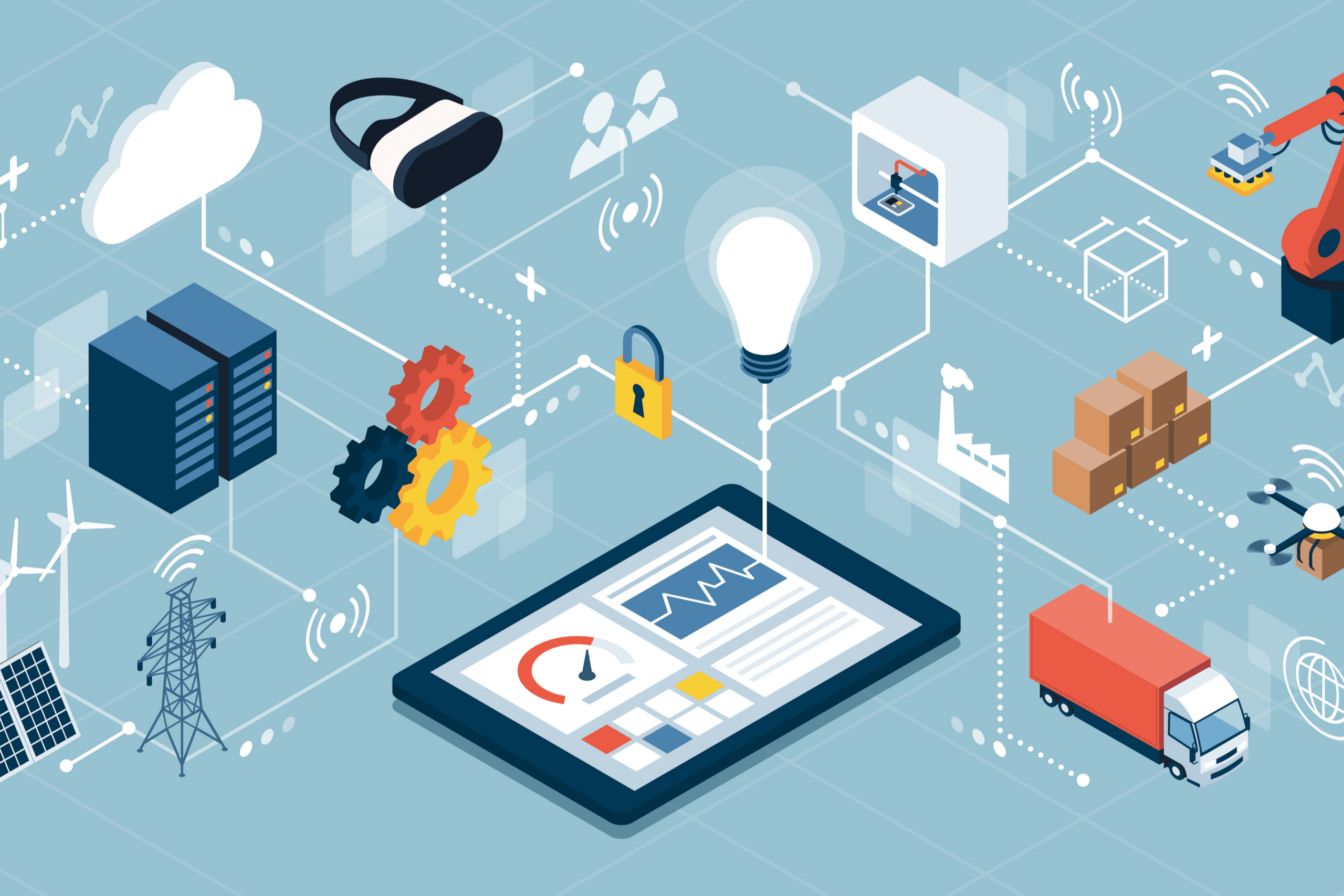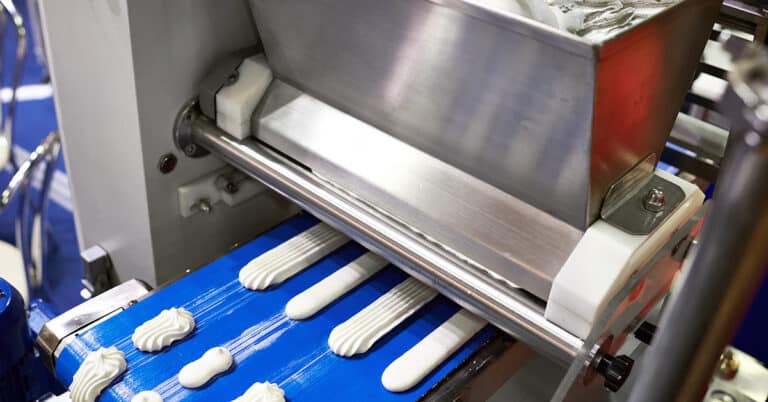Internet of Things. Smart devices. The connected factory. These are all phrases that we have heard more and more in recent years — and for good reason. They describe technology that is driving the cutting edge and future of manufacturing. IIoT stands for the Industrial Internet of Things. IIoT can be considered a shorthand summary of these advances, comprising and underlying the technology and tactics that will be at the forefront of industrial processes for years to come.
What is IIoT? At a basic level, it is any network of connected industrial sensors, equipment, machinery and devices that can collect equipment performance data; communicate it to a central repository; and be controlled in-person or remotely — often in response to insights generated by data analysis.
At its core, IIoT technology is intended to keep plant operations up and running — reducing downtime to a minimum and better ensuring that key decision-makers are aware of operations status 24/7/365. These goals are enabled by tactics, approaches and strategies such as predictive maintenance, root cause analysis, big data analytics and more.
What is the industrial internet of things? Four key components
When asking “What does IIoT mean?” the answer can include several components — based on the application at hand, the machinery in use, and the goals and needs of the organization.
Some of the most common and critical components that may be included are:
- Intelligent assets and sensors: Sensors, smart equipment and other intelligent (i.e., connected) assets form the backbone of all IIoT technology and systems. This technology enables the data collection and communication that makes IIoT what it is. While many new machines sold today are built with integrated sensors and network connectivity, the majority of IIoT implementations are accomplished through aftermarket add-ons — sensors, Wi-Fi connections, remote controls and more. The common thread through all of this equipment is that it enables real-time monitoring of intricate aspects of equipment operation, the transmission of that data, and reception of control functions.
- Data infrastructure: Smart equipment and sensors are not effective if they don’t have the right data infrastructure with which to connect. Essentially, this is a strong, high-capacity network — which may include hardwired and wireless elements — that allows communication between machines, sensors, controls and a central data repository. This infrastructure must also comprise a large amount of data storage capacity, as well as computer processing power, since data is constantly being collected, monitored and analyzed in real-time.
- Analytics: Once equipment data has been collected and transmitted to the central repository, data analytics are executed. While IIoT will often monitor basic, standard performance metrics — for benchmarking as well as for baseline performance monitoring — the true, vast potential of this technology is unlocked through advanced analytics that allows for predictive maintenance, root cause analysis and prescriptive maintenance.
- People: No technology — no matter how advanced — will be successful without the right people to design, implement, operate and take action based on it. For IIoT, this means capable, trained and certified reliability engineers, maintenance personnel and data scientists. These experts must be up to date with the latest technology, analytics and strategic trends to be most effective.
IIoT and IoT: What’s the difference?
The terms IIoT (Industrial Internet of Things) and IoT (Internet of Things) may be confusing. They are often used interchangeably — although they have different meanings. While they have similarities, the differences between them must be understood to gain maximum effectiveness from an IIoT implementation.
These differences include:
- Industrial versus general applications: As you can tell from the names, IIoT is specific to industrial applications, while IoT is a more general conception that can apply to a vast range of equipment and uses, mostly for consumer products.
- Sensors versus everything else: IIoT is based primarily on sensor technology and performance tracking. Communication and connectivity are key to IIoT as well, but act in service of the sensors. The general IoT, on the other hand, is not exclusively reliant on sensors, and can in fact cover a broad range of technology and applications — with the common thread being that a device or product is “smart” or is able to connect to the Internet.
- Closed-loop versus the open Internet: Industrial Internet of Things implementations are, in general, built as a closed-loop network. Even though access is almost always available on-site as well as remotely, to those who have access, the purpose of an IIoT system is for communication, analysis and feedback loop that occur within a controlled — and secure — ecosystem. The broader Internet of Things, on the other hand, is less security-conscious and thus more of an open system.
IIoT and artificial intelligence
Artificial intelligence and machine learning technologies are impacting IIoT and digitally connected environments in a number of ways. For example, AI can collect information from sensors and predict how soon a given component or system may break down due to wear. This enables preventive maintenance to be performed at the most convenient time to prevent any unexpected downtime. Its analytic capabilities also provide manufacturers with detailed insights about their processes that they would be unable to find otherwise. Algorithms can make determinations based on data collected from equipment much faster and with more accuracy than human observers can on their own. This in turn means manufacturers can make better-informed decisions in areas ranging from market trends to finding new revenue streams.
Another important use of AI with regard to IIoT is improving automation. Rather than being fixed to a predetermined routine, robotic equipment empowered by AI can make choices based on the information it receives in real time. This means they can operate nearly autonomously, without the need for human input in most cases.
Benefits of IIoT
IIoT offers a broad range of benefits. The list below is just a few of the most common ones — depending on need and application.
There are nearly limitless ways IIoT can improve a business:
- Advanced, ROI-driven maintenance: Implementing tactics such as machine health monitoring and condition-based monitoring, mean that IIoT technology enables more proactive, prescriptive and ROI-driven maintenance — so that critical assets are always being monitored to ensure the facility stays operating at optimal levels.
- Increased productivity: By vastly reducing unplanned downtime — allowing more control over maintenance and facilitating remote control and operations — IIoT helps to maximize output, quality and OEE, delivering benefits to the business and the customer alike.
- Improved safety: IIoT improves safety in several ways:
- By greatly reducing or eliminating catastrophic equipment failures that can create dangerous situations
- By supporting increased automation to keep human workers away from the most dangerous tasks
- By enabling off-site work, where applicable
- Asset tracking and monitoring: Connected systems can send detailed information about the status of items across the supply chain. This provides stakeholders with all the information they need to make the most informed decisions or take action to prevent issues.
IIoT industry applications
IIoT impacts all areas of manufacturing, across all industries, and can benefit any facility with manufacturing production equipment.
Some of the key areas where IIoT is becoming most prevalent include:
- Aerospace
- Automotive
- Building Products
- Heavy Equipment
- Consumer Packaged Goods
- Paper & Pulp
- Power Distribution
- Tire and Rubber
Helping manufacturers around the world
With over three decades of maintenance expertise in some of the most advanced production environments, ATS has extensive knowledge in IIoT applications and reliability-centered maintenance and implementation. We are ready to work with you to develop a plan tailored to your operational needs and objectives, using the latest IIoT technology.
For more information, contact us today.






